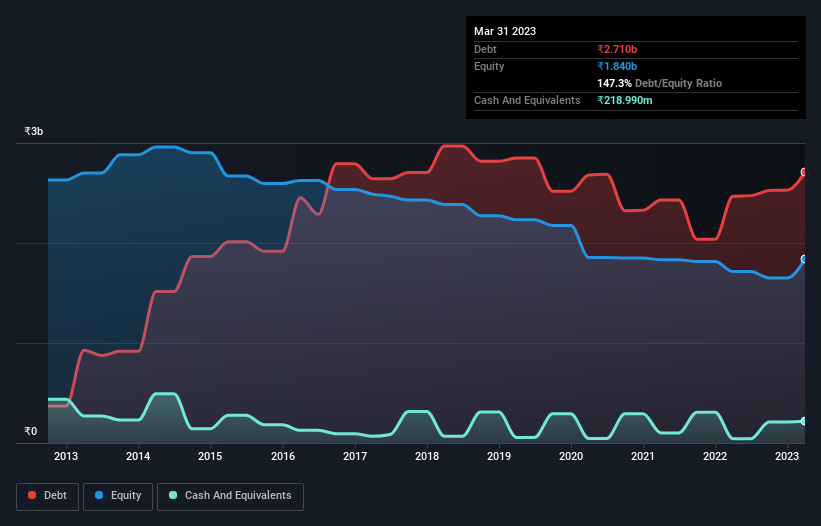Here's Why Elgi Rubber (NSE:ELGIRUBCO) Is Weighed Down By Its Debt Load
The external fund manager backed by Berkshire Hathaway's Charlie Munger, Li Lu, makes no bones about it when he says 'The biggest investment risk is not the volatility of prices, but whether you will suffer a permanent loss of capital.' It's only natural to consider a company's balance sheet when you examine how risky it is, since debt is often involved when a business collapses. As with many other companies Elgi Rubber Company Limited (NSE:ELGIRUBCO) makes use of debt. But the real question is whether this debt is making the company risky.
Why Does Debt Bring Risk?
Debt is a tool to help businesses grow, but if a business is incapable of paying off its lenders, then it exists at their mercy. Ultimately, if the company can't fulfill its legal obligations to repay debt, shareholders could walk away with nothing. However, a more common (but still painful) scenario is that it has to raise new equity capital at a low price, thus permanently diluting shareholders. By replacing dilution, though, debt can be an extremely good tool for businesses that need capital to invest in growth at high rates of return. When we examine debt levels, we first consider both cash and debt levels, together.
Check out our latest analysis for Elgi Rubber
What Is Elgi Rubber's Debt?
You can click the graphic below for the historical numbers, but it shows that as of March 2023 Elgi Rubber had ₹2.71b of debt, an increase on ₹2.47b, over one year. However, because it has a cash reserve of ₹219.0m, its net debt is less, at about ₹2.49b.

A Look At Elgi Rubber's Liabilities
We can see from the most recent balance sheet that Elgi Rubber had liabilities of ₹2.73b falling due within a year, and liabilities of ₹763.8m due beyond that. Offsetting this, it had ₹219.0m in cash and ₹677.3m in receivables that were due within 12 months. So it has liabilities totalling ₹2.59b more than its cash and near-term receivables, combined.
When you consider that this deficiency exceeds the company's ₹2.18b market capitalization, you might well be inclined to review the balance sheet intently. In the scenario where the company had to clean up its balance sheet quickly, it seems likely shareholders would suffer extensive dilution.
In order to size up a company's debt relative to its earnings, we calculate its net debt divided by its earnings before interest, tax, depreciation, and amortization (EBITDA) and its earnings before interest and tax (EBIT) divided by its interest expense (its interest cover). This way, we consider both the absolute quantum of the debt, as well as the interest rates paid on it.
Elgi Rubber shareholders face the double whammy of a high net debt to EBITDA ratio (14.9), and fairly weak interest coverage, since EBIT is just 0.02 times the interest expense. This means we'd consider it to have a heavy debt load. One redeeming factor for Elgi Rubber is that it turned last year's EBIT loss into a gain of ₹4.7m, over the last twelve months. There's no doubt that we learn most about debt from the balance sheet. But you can't view debt in total isolation; since Elgi Rubber will need earnings to service that debt. So when considering debt, it's definitely worth looking at the earnings trend. Click here for an interactive snapshot.
Finally, a business needs free cash flow to pay off debt; accounting profits just don't cut it. So it's worth checking how much of the earnings before interest and tax (EBIT) is backed by free cash flow. Over the last year, Elgi Rubber saw substantial negative free cash flow, in total. While that may be a result of expenditure for growth, it does make the debt far more risky.
Our View
To be frank both Elgi Rubber's interest cover and its track record of converting EBIT to free cash flow make us rather uncomfortable with its debt levels. Having said that, its ability to grow its EBIT isn't such a worry. Taking into account all the aforementioned factors, it looks like Elgi Rubber has too much debt. While some investors love that sort of risky play, it's certainly not our cup of tea. There's no doubt that we learn most about debt from the balance sheet. But ultimately, every company can contain risks that exist outside of the balance sheet. We've identified 4 warning signs with Elgi Rubber (at least 1 which can't be ignored) , and understanding them should be part of your investment process.
At the end of the day, it's often better to focus on companies that are free from net debt. You can access our special list of such companies (all with a track record of profit growth). It's free.
Valuation is complex, but we're here to simplify it.
Discover if Elgi Rubber might be undervalued or overvalued with our detailed analysis, featuring fair value estimates, potential risks, dividends, insider trades, and its financial condition.
Access Free AnalysisHave feedback on this article? Concerned about the content? Get in touch with us directly. Alternatively, email editorial-team (at) simplywallst.com.
This article by Simply Wall St is general in nature. We provide commentary based on historical data and analyst forecasts only using an unbiased methodology and our articles are not intended to be financial advice. It does not constitute a recommendation to buy or sell any stock, and does not take account of your objectives, or your financial situation. We aim to bring you long-term focused analysis driven by fundamental data. Note that our analysis may not factor in the latest price-sensitive company announcements or qualitative material. Simply Wall St has no position in any stocks mentioned.
About NSEI:ELGIRUBCO
Elgi Rubber
Manufactures and sells reclaimed rubber, retreading machinery, and retread rubber in India and internationally.
Slightly overvalued with imperfect balance sheet.
Similar Companies
Market Insights
Community Narratives





